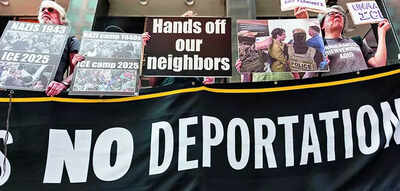ARTICLE AD BOX

For the first time in decades, more immigrants are leaving the US than arriving, a new study finds, an early indication that President Trump's hard-line immigration agenda is leading people to depart - whether through deportation or by choice.
An analysis of new census data released last week by the nonpartisan Pew Research Center found that between Jan and June, the foreign-born population in the US - both lawful and unlawful residents - declined by nearly 1.5 million. In June, the country was home to 51.9 million immigrants, down from 53.3 million six months earlier.Officials from the Trump administration have applauded the net outflow, asserting that pressures on govt services have eased and that job markets have rebounded.
And some supporters of the immigration crackdown say it hasn't gone far enough.But experts predict looming negative economic and demographic consequences for the US if the trend persists. Immigrants are a crucial workforce in many sectors, and the country's reliance on them is growing as more baby boomers retire.Lillian Divina Leite, 46, chose to use govt's new self-deportation program to return to Brazil. A housekeeper in Charlotte, North Carolina, Leite said that she had begun to panic when she saw immigrants being "hunted down like hardened criminals."
"I got really scared," said Leite, who had fallen out of legal status after overstaying a six-month tourist visa. "I thought, I haven't done anything wrong in my life," she said, "and suddenly I could be imprisoned.
"Despite the study's findings, Kevin Lynn, executive director of the Institute for Sound Public Policy, which advocates for less immigration, said that foreign workers who enter lawfully continue to pour into the United States and undermine Americans.
"There has been no letup," he said. "People coming here legally, whether on green cards or employment visas, are impacting American workers at all strata, whether low-skilled or high-skilled.
"Net migration - the difference between the number of immigrants arriving and departing - has turned negative, a shift that the chief Pew demographer, Jeffrey Passel, called a "demographic certainty" so far in 2025. His team's analysis did not calculate a separate number for immigrants without lawful status who seem likely to represent the largest number of departures, because heightened enforcement probably diminished immigrants' participation in the census survey that was used to make estimates, he said.
They may have been under-counted, which would suggest the drop is not as severe, or their low participation could mask an even more striking decline. The US experienced negative net immigration in the 1930s, during the Great Depression. "A rapid decline in immigration is going to cause economic harm," said Tara Watson, an economist at the Brookings Institution and one of the authors of the report. Political pushback and legal challenges could lead the Trump administration to ease its crackdown and, thus, soften the impact, she said.



.png)
.png)
.png)
















 4 days ago
5
4 days ago
5









 English (US) ·
English (US) ·